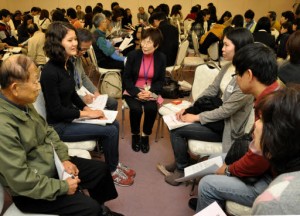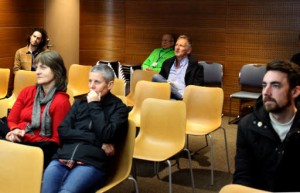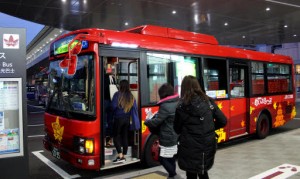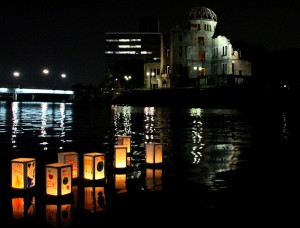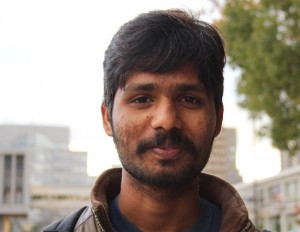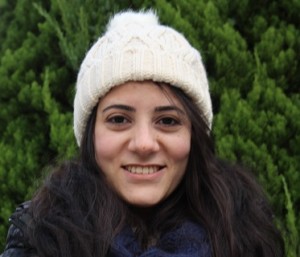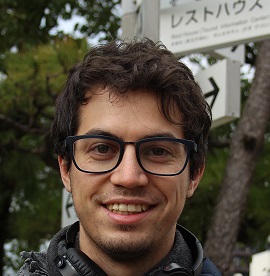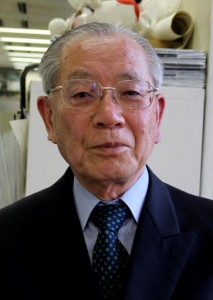Peace Seeds: Teens in Hiroshima Sow Seeds of Peace (Part 51)
Dec. 21, 2017
Enabling international visitors to experience the A-bombed city
In 2017, the Treaty on the Prohibition of Nuclear Weapons was adopted at the United Nations and the International Campaign to Abolish Nuclear Weapons (ICAN) won the Nobel Peace Prize. Meanwhile, interest in the A-bombed city of Hiroshima has surged among the international community.
For several years, the number of international visitors to Hiroshima has been rising significantly. In 2016, in the wake of U.S. President Barack Obama’s visit to Hiroshima, the number nearly tripled to about 1,180,000 people, compared to 2012. Hiroshima Peace Memorial Park teems with visitors from around the world.
What must be done to encourage first-time visitors to Hiroshima to actively share the horror of the atomic bombing and the importance of peace to others back in their nations? The junior writers considered this question, gathering information on current efforts and pondering the challenges that lie ahead.
Volunteer guides explain Hiroshima in English
Last November, the Hiroshima Interpreters for Peace (HIP), a volunteer group, held a workshop about guiding visitors to the city in English at the International Conference Center Hiroshima. We took part and practiced explaining such sites as the Children’s Peace Monument and the A-bombed aogiri tree, in English, under the guidance of HIP members.
We learned not only natural English expressions and pronunciation, but also how to explain these things by appealing to the listeners’ five senses and making suitable use of photos, pictures, and poetry. The goal is to ignite the listeners’ imagination and get them to recognize that peace and war are issues that are actually close to their own lives.
Keiko Ogura, 80, an A-bomb survivor who lives in Naka Ward and is the head of HIP, has been a volunteer guide for many years. She said, “It’s important to closely examine the content of what you’re conveying and explain your desire for peace in your own way, with your own words.” Ms. Ogura is seeking to increase the number of people who will be able to respond in English when asked questions in the city by visitors from overseas.
I think there are many people, including us, who hesitate to speak with people from other countries. Going forward, we want to summon the courage to put our ideas into action and be able to explain Hiroshima in our own words when we have the chance to guide people from abroad. (Anna Ikeda, 16, and Miyuu Okada, 16)
“Memory keepers” convey A-bomb accounts
“Memory keepers” are volunteers who help hand down the accounts of A-bomb survivors in English. They do this every day at 2 p.m. at the Hiroshima Peace Memorial Museum. Last November, we listened to a talk by Kumiko Seino, 59, a second-generation A-bomb survivor and a resident of Naka Ward. On this day, eight visitors from overseas, including countries like the United Kingdom and Australia, gathered in the room to listen.
Ms. Seino recounted the A-bomb experience of her mother, who lived in the Nakajima district before the war, where the Hiroshima Peace Memorial Park is now located, as well as the A-bomb experience of the late Keijiro Matsushima. Showing photos and pictures of the atomic bombing on a large screen, she explained how the city was devastated, including the Nakajima district and its busy shopping streets. She said, “Fire swept through the city and many people lost their lives in the atomic bombing. The remains of members of my mother’s family were never found.”
A British woman, 29, who was listening attentively, expressed surprise, saying, “I had thought that about 1,000 people were killed in the atomic bombing. This was as cruel as the Holocaust.”
These talks by the “memory keepers” are valuable opportunities and open to everyone, on any day, but the number of people attending the talks has not grown as hoped. We feel that efforts to raise more awareness of these talks are needed, such as increasing the number of sessions in English to twice a day and making more active use of social networking sites. (Hitoha Katsura, 13, and Anna Ikeda, 16)
Sightseeing bus is popular among international visitors
Since April of 2013, the Chugoku JR Bus Company has operated the Hiroshima Meipuru-pu, a sightseeing loop bus that runs through the city center. Each day, 47 buses arrive and depart from JR Hiroshima Station. About 70 percent of the passengers are international visitors and most get on and off at the bus stops by the A-bomb Dome and the Hiroshima Peace Memorial Museum.
We rode the bus ourselves. The signs for the bus stops feature a logo with a maple leaf and the names of the destinations written in English so international visitors are able to use the bus route easily without getting lost. When the bus passes alongside the Peace Memorial Park, there is an announcement that explains the damage caused by the atomic bomb, but this explanation is given only in Japanese and we feel it should be made in English, too.
Thanks to favorable word-of-mouth online, the total number of passengers topped 1 million last March. Nobuhiro Nishimura, 53, from the the company’s transport section, told us, “We want international visitors to see the sights of the city without feeling any stress. How to give more guide information at the bus stops is a future challenge for us.” We think that the people riding these buses would have more opportunity to think about peace and the reconstruction of the city if the buildings and trees that survived the atomic bombing were explained on the bus when it passes by these sites. (Hinako Okada, 16, and Hitoha Katsura, 13)
Interviews in the Peace Memorial Park
Serni Solans, 26, from Spain
I feel haunted by the Atomic Bomb Memorial Mound. I couldn’t let go of my feelings of sadness, anger, and revulsion until I stepped away from the park. The A-bomb Dome, standing near the river, conveys the horror of the atomic bomb, but it’s also an impressive and beautiful sight. Many people I know aren’t aware of how Hiroshima was able to reconstruct the city after the atomic bombing. The City of Hiroshima should actively provide information online and host conferences that are related to peace here.
Shaimaa Ahmed, 30, from Egypt
I walked around the Hiroshima Peace Memorial Park and was impressed by the many beautiful and peaceful sights. Apart from the Hiroshima Peace Memorial Museum and the A-bomb Dome, I was especially impressed by the Flame of Peace. If the City of Hiroshima wants to promote peace tourism, I hope that it will improve the signs in English for these places, like the monuments.
Karisidda Swamy, 26, from India
There is a space in the International Conference Center Hiroshima where we can freely read books or magazines, which I found convenient. I enjoyed spending time sitting on the bank of the river opposite the A-bomb Dome. I think there should be more signs in multiple languages. Another suggestion would be to launch a social networking site that focuses on the Peace Memorial Park, sends out information each day, and elicits people’s opinions.
Council to promote peace tourism in Hiroshima
In 2016, about 60 percent of the international visitors to Hiroshima were from the United States, Europe, and Oceania, and most of them visit the Peace Memorial Park. But about 45 percent of them come here on a day trip and don’t stay overnight in the city.
In 2017, the City of Hiroshima formed a council to promote peace tourism and discuss sightseeing tours to places connected to the atomic bombing, peace, and reconstruction, including buildings and trees that survived the atomic bombing and Mazda baseball stadium. Some people are against the idea of linking peace to sightseeing, but Hiroshi Harada, 78, an A-bomb survivor who lives in Asaminami Ward and the president of the council, said, “It’s important to wholeheartedly convey Hiroshima’s wish for peace based on the terrible experience of the atomic bombing.”
Members of the council have made such comments as: “The traffic signs are hard to understand”; “Important explanations are inscribed on the back of monuments in Japanese, but not in English”; and “City administrators, people in the private sector, and citizens need to work together more effectively to welcome visitors warmly to the city.”
Mr. Harada said with conviction, “If we send out messages of peace to the world and the number of visitors to Hiroshima increases, the local economy will also benefit. We should continue promoting tourism to the city while thinking carefully about each step we take.” In our opinion, as junior writers, if more efforts are made so that visitors can also enjoy the city’s arts, like the Shinto music and dancing of kagura and concerts put on by local citizens, by making use of art museums and the site of the old ballpark, the number of people who stay longer in Hiroshima may rise. (Aoi Nakagawa, 15, and Hitoha Katsura, 13)
Activities for international visitors to experience Hiroshima
There are a growing number of sightseeing tours for international visitors to experience peace activities in Hiroshima. I checked the Internet for information and found that an event company here offers a plan where visitors can float a paper lantern on the water from the bank of the river across from the A-bomb Dome. The participants write a message on the lantern and let it float down the river, with thoughts of peace.
The Hiroshima Orizuru Tower, which opened in front of the Peace Memorial Park in the fall of 2016, enables visitors to fold paper cranes and drop them into a space behind a glass-paneled wall. Other activities in the city are a sightseeing tour by bicycle to visit buildings that survived the atomic bombing and a café where international visitors can interact with A-bomb survivors. Visitors to Hiroshima now have wider opportunities to think about peace in various ways. (Aya Tadokoro, 14)
Junior writers’ impressions
A sightseeing tour to visit a war- or disaster-related site is generally called “dark tourism,” but the City of Hiroshima uses a positive term, “peace tourism.” I think this is a good expression for Hiroshima’s mission. The number of international visitors to Hiroshima has been growing each year. But I heard that they know very little about the damage caused by the atomic bombing. I hope that conveying the A-bomb experience in English will enable them to know more about it. In addition, the public facilities here are becoming better suited to international visitors, and I hope they can tour the sights of Hiroshima smoothly. Hiroshima has recovered from its terrible past and is now a wonderful city. I want to tell people overseas that they should definitely visit Hiroshima. (Hitoha Katsura)
Through the interview I took part in, I thought I need to know more about Hiroshima and talk to people not only as a guide but also as someone who lives here when I have the chance to show international visitors around the city. (Miyuu Okada)
The International Campaign to Abolish Nuclear Weapons (ICAN), the non-governmental organization (NGO) that won the Nobel Peace Prize this year, has been campaigning for the abolition of nuclear weapons. This historic development is now drawing more attention to the A-bombed city of Hiroshima. To me, Hiroshima equals the A-bombed city, but through the interview I did, I realized that many international visitors don’t really know the full horror of the A-bomb attack and the danger posed by nuclear weapons. As a native of Hiroshima, I now realize the importance of handing down the sentiments of the A-bomb survivors and conveying them to the world, and I feel strongly that the challenge ahead is to strengthen people’s awareness of the city, not merely make it more famous. (Anna Ikeda)
When I was researching activities for peace tourism in Hiroshima, I found that private companies are pursuing efforts for this in various ways. The more services there are for peace tourism, the more international visitors can learn about the horror of the atomic bombing and the more their hearts will be moved to desire peace. As I wasn’t aware of these activities, I’d like to see them become more widely known. I also hope that international visitors will experience the things they can do while they’re here in Hiroshima, like floating a paper lantern on the river. (Aya Tadokoro)
I interviewed Hiroshi Harada, who was formerly the director of the Hiroshima Peace Memorial Museum. I was pleased to hear important stories about peace tourism and how the A-bomb Dome was designated a World Heritage site. In the future, I hope that many more international visitors will deepen their understanding of peace through peace tourism. (Aoi Nakagawa)
What is Peace Seeds?
Peace Seeds are the seeds of smiles which can be spread around the world by thinking about peace and the preciousness of life from various viewpoints. To fill this world with flowering smiles, the junior writers, currently consisting of 25 junior high and high school students, choose themes, gather information, and write articles.
(Originally published on December 21, 2017)
In 2017, the Treaty on the Prohibition of Nuclear Weapons was adopted at the United Nations and the International Campaign to Abolish Nuclear Weapons (ICAN) won the Nobel Peace Prize. Meanwhile, interest in the A-bombed city of Hiroshima has surged among the international community.
For several years, the number of international visitors to Hiroshima has been rising significantly. In 2016, in the wake of U.S. President Barack Obama’s visit to Hiroshima, the number nearly tripled to about 1,180,000 people, compared to 2012. Hiroshima Peace Memorial Park teems with visitors from around the world.
What must be done to encourage first-time visitors to Hiroshima to actively share the horror of the atomic bombing and the importance of peace to others back in their nations? The junior writers considered this question, gathering information on current efforts and pondering the challenges that lie ahead.
Volunteer guides explain Hiroshima in English
Last November, the Hiroshima Interpreters for Peace (HIP), a volunteer group, held a workshop about guiding visitors to the city in English at the International Conference Center Hiroshima. We took part and practiced explaining such sites as the Children’s Peace Monument and the A-bombed aogiri tree, in English, under the guidance of HIP members.
We learned not only natural English expressions and pronunciation, but also how to explain these things by appealing to the listeners’ five senses and making suitable use of photos, pictures, and poetry. The goal is to ignite the listeners’ imagination and get them to recognize that peace and war are issues that are actually close to their own lives.
Keiko Ogura, 80, an A-bomb survivor who lives in Naka Ward and is the head of HIP, has been a volunteer guide for many years. She said, “It’s important to closely examine the content of what you’re conveying and explain your desire for peace in your own way, with your own words.” Ms. Ogura is seeking to increase the number of people who will be able to respond in English when asked questions in the city by visitors from overseas.
I think there are many people, including us, who hesitate to speak with people from other countries. Going forward, we want to summon the courage to put our ideas into action and be able to explain Hiroshima in our own words when we have the chance to guide people from abroad. (Anna Ikeda, 16, and Miyuu Okada, 16)
“Memory keepers” convey A-bomb accounts
“Memory keepers” are volunteers who help hand down the accounts of A-bomb survivors in English. They do this every day at 2 p.m. at the Hiroshima Peace Memorial Museum. Last November, we listened to a talk by Kumiko Seino, 59, a second-generation A-bomb survivor and a resident of Naka Ward. On this day, eight visitors from overseas, including countries like the United Kingdom and Australia, gathered in the room to listen.
Ms. Seino recounted the A-bomb experience of her mother, who lived in the Nakajima district before the war, where the Hiroshima Peace Memorial Park is now located, as well as the A-bomb experience of the late Keijiro Matsushima. Showing photos and pictures of the atomic bombing on a large screen, she explained how the city was devastated, including the Nakajima district and its busy shopping streets. She said, “Fire swept through the city and many people lost their lives in the atomic bombing. The remains of members of my mother’s family were never found.”
A British woman, 29, who was listening attentively, expressed surprise, saying, “I had thought that about 1,000 people were killed in the atomic bombing. This was as cruel as the Holocaust.”
These talks by the “memory keepers” are valuable opportunities and open to everyone, on any day, but the number of people attending the talks has not grown as hoped. We feel that efforts to raise more awareness of these talks are needed, such as increasing the number of sessions in English to twice a day and making more active use of social networking sites. (Hitoha Katsura, 13, and Anna Ikeda, 16)
Sightseeing bus is popular among international visitors
Since April of 2013, the Chugoku JR Bus Company has operated the Hiroshima Meipuru-pu, a sightseeing loop bus that runs through the city center. Each day, 47 buses arrive and depart from JR Hiroshima Station. About 70 percent of the passengers are international visitors and most get on and off at the bus stops by the A-bomb Dome and the Hiroshima Peace Memorial Museum.
We rode the bus ourselves. The signs for the bus stops feature a logo with a maple leaf and the names of the destinations written in English so international visitors are able to use the bus route easily without getting lost. When the bus passes alongside the Peace Memorial Park, there is an announcement that explains the damage caused by the atomic bomb, but this explanation is given only in Japanese and we feel it should be made in English, too.
Thanks to favorable word-of-mouth online, the total number of passengers topped 1 million last March. Nobuhiro Nishimura, 53, from the the company’s transport section, told us, “We want international visitors to see the sights of the city without feeling any stress. How to give more guide information at the bus stops is a future challenge for us.” We think that the people riding these buses would have more opportunity to think about peace and the reconstruction of the city if the buildings and trees that survived the atomic bombing were explained on the bus when it passes by these sites. (Hinako Okada, 16, and Hitoha Katsura, 13)
Interviews in the Peace Memorial Park
Serni Solans, 26, from Spain
I feel haunted by the Atomic Bomb Memorial Mound. I couldn’t let go of my feelings of sadness, anger, and revulsion until I stepped away from the park. The A-bomb Dome, standing near the river, conveys the horror of the atomic bomb, but it’s also an impressive and beautiful sight. Many people I know aren’t aware of how Hiroshima was able to reconstruct the city after the atomic bombing. The City of Hiroshima should actively provide information online and host conferences that are related to peace here.
Shaimaa Ahmed, 30, from Egypt
I walked around the Hiroshima Peace Memorial Park and was impressed by the many beautiful and peaceful sights. Apart from the Hiroshima Peace Memorial Museum and the A-bomb Dome, I was especially impressed by the Flame of Peace. If the City of Hiroshima wants to promote peace tourism, I hope that it will improve the signs in English for these places, like the monuments.
Karisidda Swamy, 26, from India
There is a space in the International Conference Center Hiroshima where we can freely read books or magazines, which I found convenient. I enjoyed spending time sitting on the bank of the river opposite the A-bomb Dome. I think there should be more signs in multiple languages. Another suggestion would be to launch a social networking site that focuses on the Peace Memorial Park, sends out information each day, and elicits people’s opinions.
Council to promote peace tourism in Hiroshima
In 2016, about 60 percent of the international visitors to Hiroshima were from the United States, Europe, and Oceania, and most of them visit the Peace Memorial Park. But about 45 percent of them come here on a day trip and don’t stay overnight in the city.
In 2017, the City of Hiroshima formed a council to promote peace tourism and discuss sightseeing tours to places connected to the atomic bombing, peace, and reconstruction, including buildings and trees that survived the atomic bombing and Mazda baseball stadium. Some people are against the idea of linking peace to sightseeing, but Hiroshi Harada, 78, an A-bomb survivor who lives in Asaminami Ward and the president of the council, said, “It’s important to wholeheartedly convey Hiroshima’s wish for peace based on the terrible experience of the atomic bombing.”
Members of the council have made such comments as: “The traffic signs are hard to understand”; “Important explanations are inscribed on the back of monuments in Japanese, but not in English”; and “City administrators, people in the private sector, and citizens need to work together more effectively to welcome visitors warmly to the city.”
Mr. Harada said with conviction, “If we send out messages of peace to the world and the number of visitors to Hiroshima increases, the local economy will also benefit. We should continue promoting tourism to the city while thinking carefully about each step we take.” In our opinion, as junior writers, if more efforts are made so that visitors can also enjoy the city’s arts, like the Shinto music and dancing of kagura and concerts put on by local citizens, by making use of art museums and the site of the old ballpark, the number of people who stay longer in Hiroshima may rise. (Aoi Nakagawa, 15, and Hitoha Katsura, 13)
Activities for international visitors to experience Hiroshima
There are a growing number of sightseeing tours for international visitors to experience peace activities in Hiroshima. I checked the Internet for information and found that an event company here offers a plan where visitors can float a paper lantern on the water from the bank of the river across from the A-bomb Dome. The participants write a message on the lantern and let it float down the river, with thoughts of peace.
The Hiroshima Orizuru Tower, which opened in front of the Peace Memorial Park in the fall of 2016, enables visitors to fold paper cranes and drop them into a space behind a glass-paneled wall. Other activities in the city are a sightseeing tour by bicycle to visit buildings that survived the atomic bombing and a café where international visitors can interact with A-bomb survivors. Visitors to Hiroshima now have wider opportunities to think about peace in various ways. (Aya Tadokoro, 14)
Junior writers’ impressions
A sightseeing tour to visit a war- or disaster-related site is generally called “dark tourism,” but the City of Hiroshima uses a positive term, “peace tourism.” I think this is a good expression for Hiroshima’s mission. The number of international visitors to Hiroshima has been growing each year. But I heard that they know very little about the damage caused by the atomic bombing. I hope that conveying the A-bomb experience in English will enable them to know more about it. In addition, the public facilities here are becoming better suited to international visitors, and I hope they can tour the sights of Hiroshima smoothly. Hiroshima has recovered from its terrible past and is now a wonderful city. I want to tell people overseas that they should definitely visit Hiroshima. (Hitoha Katsura)
Through the interview I took part in, I thought I need to know more about Hiroshima and talk to people not only as a guide but also as someone who lives here when I have the chance to show international visitors around the city. (Miyuu Okada)
The International Campaign to Abolish Nuclear Weapons (ICAN), the non-governmental organization (NGO) that won the Nobel Peace Prize this year, has been campaigning for the abolition of nuclear weapons. This historic development is now drawing more attention to the A-bombed city of Hiroshima. To me, Hiroshima equals the A-bombed city, but through the interview I did, I realized that many international visitors don’t really know the full horror of the A-bomb attack and the danger posed by nuclear weapons. As a native of Hiroshima, I now realize the importance of handing down the sentiments of the A-bomb survivors and conveying them to the world, and I feel strongly that the challenge ahead is to strengthen people’s awareness of the city, not merely make it more famous. (Anna Ikeda)
When I was researching activities for peace tourism in Hiroshima, I found that private companies are pursuing efforts for this in various ways. The more services there are for peace tourism, the more international visitors can learn about the horror of the atomic bombing and the more their hearts will be moved to desire peace. As I wasn’t aware of these activities, I’d like to see them become more widely known. I also hope that international visitors will experience the things they can do while they’re here in Hiroshima, like floating a paper lantern on the river. (Aya Tadokoro)
I interviewed Hiroshi Harada, who was formerly the director of the Hiroshima Peace Memorial Museum. I was pleased to hear important stories about peace tourism and how the A-bomb Dome was designated a World Heritage site. In the future, I hope that many more international visitors will deepen their understanding of peace through peace tourism. (Aoi Nakagawa)
What is Peace Seeds?
Peace Seeds are the seeds of smiles which can be spread around the world by thinking about peace and the preciousness of life from various viewpoints. To fill this world with flowering smiles, the junior writers, currently consisting of 25 junior high and high school students, choose themes, gather information, and write articles.
(Originally published on December 21, 2017)

